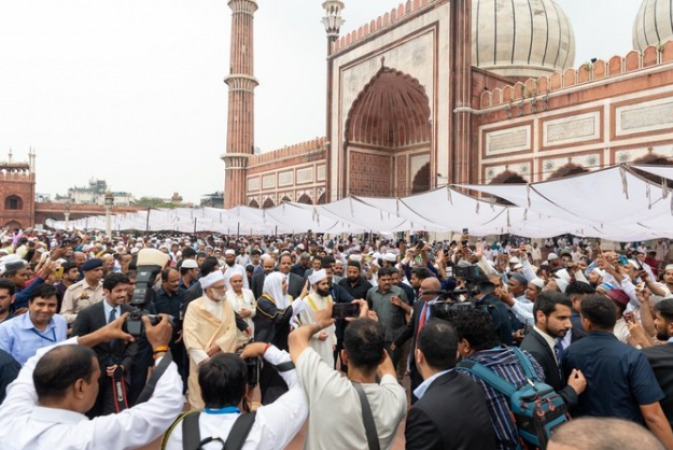
New Delhi: The Masjid-e-Jahan Numa, also known as the Jama Masjid, is one of the biggest, loveliest, and most revered places of worship on the Indian subcontinent. It was constructed by the Mughal Empire about 400 years ago in the Indian city of Delhi.
Standing room only was present when Sheikh Mohammed bin Abdulkarim Al-Issa, secretary-general of the Muslim World League and head of the Organization of Muslim Scholars, gave the Friday sermon last week, despite the complex having a capacity for 85,000 worshipers.
It was the first time in 400 years that a religious leader from outside of India had given a sermon at the mosque, according to the MWL website. Al-Issa did so at its imam's invitation and with the support of the congregation.
The fifth Mughal emperor of India, Shah Jahan, oversaw the Jama Masjid's completion in 1656. Since then, the mosque has influenced Delhi residents' and the larger Indian nation's collective popular memory.
In her essay "Mosque, Memory and State: A Case Study of Jama Masjid (India) and the Colonial State c. 1857," published in 2017, research scholar Sadia Aziz of the University of Delhi noted that the mosque's foundation stone was laid on October 6, 1650, under the supervision of Saadullah Khan, the prime minister, and Fazil Khan, the head of Shahjahan's household establishment, at a cost of ten lac rupees. (In the Indian numbering system, a lac is a unit equivalent to 100,000.)
It was constructed 1,000 yards from the Red Fort, the palace-fortress of the Mughal empire in their recently established capital, Shahjahanabad, on a hill called Bhojla Pahari.
The mosque was approximately 261 feet long and 90 feet wide, with three domes atop it that were striped with black and white marble.
Also Read: Teixeira requests a judge's release while awaiting trial, citing the Trump case as justificationThe UK will spend $3 billion on munitions and stockpiles as the Ukraine war depletes its reserves
The Jama Masjid has three entrances: the northern, southern, and eastern. Of these, the Shahi gate was the only one reserved for the emperor, who would travel from the Red Fort every Friday and on Eid days in a procession with princes, nobles, and their entourage.
There are two names for the mosque, the first of which is the regal one that the emperor gave it: Masjid-i-Jahan Numa. "Jahan" denotes the "world" and "Numa" denotes the "visible," denoting, figuratively, a structure that commands a view of the entire world.
The second name, Jama Masjid, which means "collective or congregational masjid," was born out of the populace's social consciousness and over time surpassed the official name in popularity.
Colonial authorities helped with the mosque's repair and renovation when Delhi was taken over by the British in 1803, leaving the Mughal emperor in place as the ceremonial imperial head.
However, during the uprising of 1857, also known as the Indian Mutiny or the First War of Independence, such colonial authorities' attempts to win over the local populace came to an abrupt end.
The Muslim community was specifically targeted when colonial authority was reinstated in the middle of September 1857 because the British believed the uprising to be a Muslim plot against them. As a result, many mosques in Delhi were destroyed.
The British discussed a number of options regarding what would happen to the Jama Masjid. Plans included everything from demolish to convert to a church or secular college. In the end, a scheme was hatched to convert it into barracks for Punjabi Sikh soldiers.
After this initial planning, however, the colonial authorities changed course and attempted to use the mosque as a negotiating tool to gain the support of Delhi's Muslim populace. On November 28, 1862, the mosque was given back to the Old City residents after much petitioning, but not before a number of guidelines for worshipers were put in place.
It was therefore a moment of great significance to have the head of the MWL deliver the Friday sermon and lead prayer before a congregation that reflected the diversity and unity of contemporary India, given the long and troubled history of the Jama Masjid.
Also Read: Russia conducts airstrikes on Ukraine's south and east, according to the Ukrainian Air Force
Al-Issa led a MWL delegation into the city on July 10 after receiving a formal invitation from the Indian government. He had meetings with Smriti Irani, the Minister for Minority Affairs, Prime Minister Narendra Modi, and Indian President Droupadi Murmu while in India. Additionally, he met with top Islamic scholars from India as well as leaders from other religions.